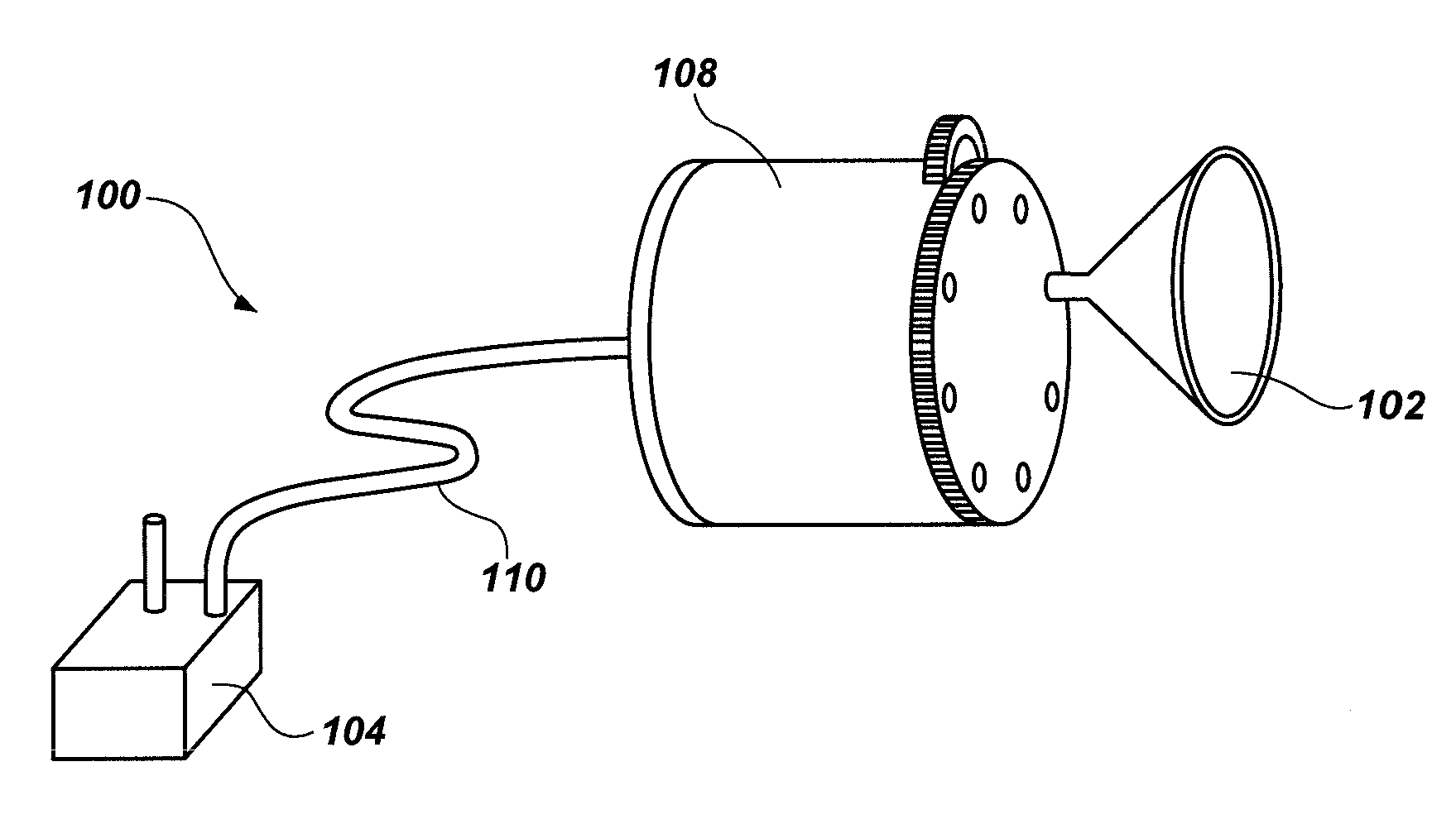Devices for collecting chemical compounds
a technology for chemical compounds and devices, applied in the field of devices and methods for collecting chemical compounds, can solve the problems of a significant number of casualties, difficult analytical characterization of cas compounds on fixed surfaces, and inability to identify agents alone to provide substantial forensic information, etc., and achieve the effect of reducing the pressure within the chamber and reducing the pressur
- Summary
- Abstract
- Description
- Claims
- Application Information
AI Technical Summary
Benefits of technology
Problems solved by technology
Method used
Image
Examples
example 1
[0091]To standardize comparison, test samples were prepared including 400 μg of tributyl phosphate (TBP) on filter paper (WHATMAN® Grade 41 quantitative filter paper, which is commercially available from Whatman Inc., Piscataway, N.J.) and / or glass.
[0092]FIGS. 5A and 5B show a schematic comparison of design and function of extraction of compounds of interest 501 using an SPME fiber 506 overlying test samples 516 at atmospheric pressure and in the presence of a vacuum pressure. There are multiple interactions that have different equilibrium and kinetic rates. There is the rate of volatilization of the target compounds from the surface material, the rate that the target compounds sorb onto the parts of the device (i.e., the wall of the chamber), and the rate that the target compounds sorb to the SPME fiber. FIG. 5A illustrates that the amount of target compound that could be sorbed onto the SPME fiber in the headspace at atmosphere would be rather low, if seen at all. However, a small...
example 2
[0096]Tests were conducted to determine which type of SPME fiber works best for detecting the CAS of interest. Some of the SPME fiber types tested include 100 μm polydimethylsiloxane, 85 μm polyacrylate, 75 μm carboxen-polydimethylsiloxane, 85 μm carboxen-polydimethylsiloxane, 65 μm polydimethylsiloxane-divinylbenzene, and 7 μm polydimethylsiloxane. Even for a given fiber material (e.g., polydimethylsiloxane), the physical characteristics also play a role in how well the SPME absorbs an analyte. As illustrated in FIGS. 7A through 7C, there may be a substantially significant difference in response for the same CAS analyte for different fiber types. FIG. 7A is a gas chromatogram obtained for DIMP using the 7 μm polydimethylsiloxane. FIG. 7B is a gas chromatogram obtained for DIMP using the 65 μm polydimethylsiloxane-divinylbenzene. FIG. 7C is a gas chromatogram obtained for DIMP using the 85 μm carboxen-polydimethylsiloxane. The 85 μm carboxen-polydimethylsiloxane demonstrated improve...
example 3
[0097]Trace quantities of CAS compounds were applied to surfaces and were sampled using the portable extraction device 200 described with respect to FIG. 2, which produced exposed SPME fibers that were analyzed using TD / GC / MS. Glass was chosen for a non-absorptive surface because it is a matrix that is of significant forensic value, and because its surface could be effectively cleaned, removing background from the subsequent GC / MS analyses that were performed. This latter consideration is important because it simplified the analyses and subsequent interpretations, easing identification of signature compounds, impurities and degradation products.
[0098]Diethylphosphite (DEPt) is a relatively small molecule, which may lead to the expectation that it may readily partition into the gas phase, and perhaps volatilize before it could be effectively sampled. However, DEPt also has a significant P—O (phosphorous-oxygen) dipole that may produce very strong bonding with both Lewis and Bronsted ...
PUM
| Property | Measurement | Unit |
|---|---|---|
| temperature | aaaaa | aaaaa |
| atmospheric pressure | aaaaa | aaaaa |
| pressures | aaaaa | aaaaa |
Abstract
Description
Claims
Application Information
 Login to View More
Login to View More - R&D
- Intellectual Property
- Life Sciences
- Materials
- Tech Scout
- Unparalleled Data Quality
- Higher Quality Content
- 60% Fewer Hallucinations
Browse by: Latest US Patents, China's latest patents, Technical Efficacy Thesaurus, Application Domain, Technology Topic, Popular Technical Reports.
© 2025 PatSnap. All rights reserved.Legal|Privacy policy|Modern Slavery Act Transparency Statement|Sitemap|About US| Contact US: help@patsnap.com



